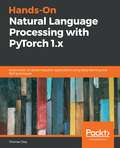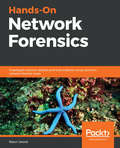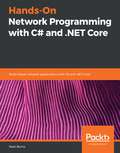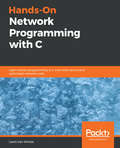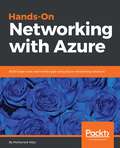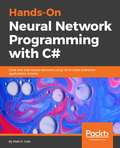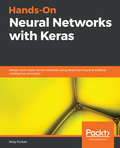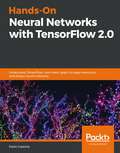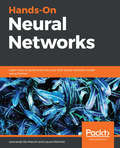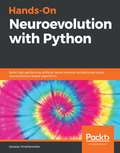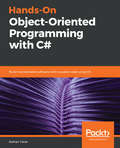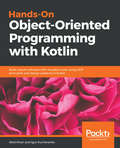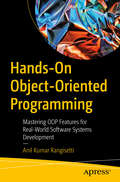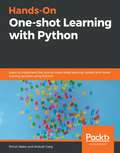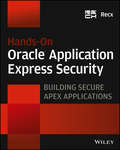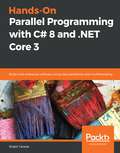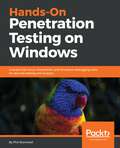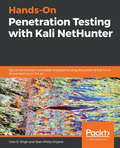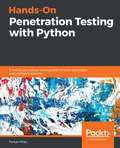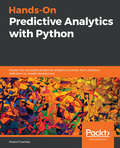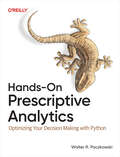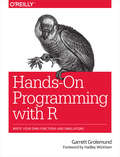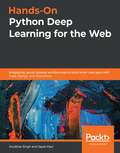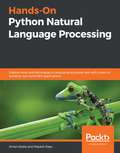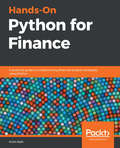- Table View
- List View
Hands-On Natural Language Processing with PyTorch 1.x: Build smart, AI-driven linguistic applications using deep learning and NLP techniques
by Thomas DopBecome a proficient NLP data scientist by developing deep learning models for NLP and extract valuable insights from structured and unstructured data Key Features Get to grips with word embeddings, semantics, labeling, and high-level word representations using practical examples Learn modern approaches to NLP and explore state-of-the-art NLP models using PyTorch Improve your NLP applications with innovative neural networks such as RNNs, LSTMs, and CNNs Book Description In the internet age, where an increasing volume of text data is generated daily from social media and other platforms, being able to make sense of that data is a crucial skill. With this book, you'll learn how to extract valuable insights from text by building deep learning models for natural language processing (NLP) tasks. Starting by understanding how to install PyTorch and using CUDA to accelerate the processing speed, you'll explore how the NLP architecture works with the help of practical examples. This PyTorch NLP book will guide you through core concepts such as word embeddings, CBOW, and tokenization in PyTorch. You'll then learn techniques for processing textual data and see how deep learning can be used for NLP tasks. The book demonstrates how to implement deep learning and neural network architectures to build models that will allow you to classify and translate text and perform sentiment analysis. Finally, you'll learn how to build advanced NLP models, such as conversational chatbots. By the end of this book, you'll not only have understood the different NLP problems that can be solved using deep learning with PyTorch, but also be able to build models to solve them. What you will learn Use NLP techniques for understanding, processing, and generating text Understand PyTorch, its applications and how it can be used to build deep linguistic models Explore the wide variety of deep learning architectures for NLP Develop the skills you need to process and represent both structured and unstructured NLP data Become well-versed with state-of-the-art technologies and exciting new developments in the NLP domain Create chatbots using attention-based neural networks Who this book is for This PyTorch book is for NLP developers, machine learning and deep learning developers, and anyone interested in building intelligent language applications using both traditional NLP approaches and deep learning architectures. If you're looking to adopt modern NLP techniques and models for your development projects, this book is for you. Working knowledge of Python programming, along with basic working knowledge of NLP tasks, is required.
Hands-On Network Forensics: Investigate network attacks and find evidence using common network forensic tools
by Nipun JaswalGain basic skills in network forensics and learn how to apply them effectively Key Features Investigate network threats with ease Practice forensics tasks such as intrusion detection, network analysis, and scanning Learn forensics investigation at the network level Book Description Network forensics is a subset of digital forensics that deals with network attacks and their investigation. In the era of network attacks and malware threat, it's now more important than ever to have skills to investigate network attacks and vulnerabilities. Hands-On Network Forensics starts with the core concepts within network forensics, including coding, networking, forensics tools, and methodologies for forensic investigations. You'll then explore the tools used for network forensics, followed by understanding how to apply those tools to a PCAP file and write the accompanying report. In addition to this, you will understand how statistical flow analysis, network enumeration, tunneling and encryption, and malware detection can be used to investigate your network. Towards the end of this book, you will discover how network correlation works and how to bring all the information from different types of network devices together. By the end of this book, you will have gained hands-on experience of performing forensics analysis tasks. What you will learn Discover and interpret encrypted traffic Learn about various protocols Understand the malware language over wire Gain insights into the most widely used malware Correlate data collected from attacks Develop tools and custom scripts for network forensics automation Who this book is for The book targets incident responders, network engineers, analysts, forensic engineers and network administrators who want to extend their knowledge from the surface to the deep levels of understanding the science behind network protocols, critical indicators in an incident and conducting a forensic search over the wire.
Hands-On Network Programming with C# and .NET Core: Build robust network applications with C#and .NET Core
by Sean BurnsA comprehensive guide to understanding network architecture, communication protocols, and network analysis to build secure applications compatible with the latest versions of C# 8 and .NET Core 3.0 Key Features Explore various network architectures that make distributed programming possible Learn how to make reliable software by writing secure interactions between clients and servers Use .NET Core for network device automation, DevOps, and software-defined networking Book Description The C# language and the .NET Core application framework provide the tools and patterns required to make the discipline of network programming as intuitive and enjoyable as any other aspect of C# programming. With the help of this book, you will discover how the C# language and the .NET Core framework make this possible. The book begins by introducing the core concepts of network programming, and what distinguishes this field of programming from other disciplines. After this, you will gain insights into concepts such as transport protocols, sockets and ports, and remote data streams, which will provide you with a holistic understanding of how network software fits into larger distributed systems. The book will also explore the intricacies of how network software is implemented in a more explicit context, by covering sockets, connection strategies such as Transmission Control Protocol (TCP) and User Datagram Protocol (UDP), asynchronous processing, and threads. You will then be able to work through code examples for TCP servers, web APIs served over HTTP, and a Secure Shell (SSH) client. By the end of this book, you will have a good understanding of the Open Systems Interconnection (OSI) network stack, the various communication protocols for that stack, and the skills that are essential to implement those protocols using the C# programming language and the .NET Core framework. What you will learn Understand the breadth of C#'s network programming utility classes Utilize network-layer architecture and organizational strategies Implement various communication and transport protocols within C# Discover hands-on examples of distributed application development Gain hands-on experience with asynchronous socket programming and streams Learn how C# and the .NET Core runtime interact with a hosting network Understand a full suite of network programming tools and features Who this book is for If you're a .NET developer or a system administrator with .NET experience and are looking to get started with network programming, then this book is for you. Basic knowledge of C# and .NET is assumed, in addition to a basic understanding of common web protocols and some high-level distributed system designs.
Hands-On Network Programming with C: Learn socket programming in C and write secure and optimized network code
by Lewis Van WinkleA comprehensive guide to programming with network sockets, implementing Internet protocols, designing IoT devices, and much more with CKey FeaturesLeverage your C or C++ programming skills to build powerful network applicationsGet to grips with a variety of network protocols that allow you to load web pages, send emails, and do much moreWrite portable network code for operating systems such as Windows, Linux, and macOSBook DescriptionNetwork programming, a challenging topic in C, is made easy to understand with a careful exposition of socket programming APIs. This book gets you started with modern network programming in C and the right use of relevant operating system APIs.This book covers core concepts, such as hostname resolution with DNS, that are crucial to the functioning of the modern web. You’ll delve into the fundamental network protocols, TCP and UDP. Essential techniques for networking paradigms such as client-server and peer-to-peer models are explained with the help of practical examples. You’ll also study HTTP and HTTPS (the protocols responsible for web pages) from both the client and server perspective. To keep up with current trends, you’ll apply the concepts covered in this book to gain insights into web programming for IoT. You’ll even get to grips with network monitoring and implementing security best practices.By the end of this book, you’ll have experience of working with client-server applications, and be able to implement new network programs in C.The code in this book is compatible with the older C99 version as well as the latest C18 and C++17 standards. Special consideration is given to writing robust, reliable, and secure code that is portable across operating systems, including Winsock sockets for Windows and POSIX sockets for Linux and macOS.What you will learnUncover cross-platform socket programming APIsImplement techniques for supporting IPv4 and IPv6Understand how TCP and UDP connections work over IPDiscover how hostname resolution and DNS workInterface with web APIs using HTTP and HTTPSAcquire hands-on experience with Simple Mail Transfer Protocol (SMTP)Apply network programming to the Internet of Things (IoT)Who this book is forIf you're a developer or a system administrator who wants to enter the world of network programming, this book is for you. Basic knowledge of C programming is assumed.
Hands-On Networking with Azure: Build large-scale, real-world apps using Azure networking solutions
by Mohamed WalyA step-by-step guide to get you up and running with Azure Networking Services and help you build solutions that leverage effective design patternsKey FeaturesLearn best practices for designing and implementing Azure Networking for Azure VMsFigure out the hidden secrets to designing a cost-effective environmentPlan, design, and implement various connectivity scenarios in AzureBook DescriptionMicrosoft Azure networking is one of themost valuable and important offeringsin Azure. No matter what solution youare building for the cloud, you'll find acompelling use for it. This book will getyou up to speed quickly on MicrosoftAzure Networking by teaching you howto use different networking services.By reading this book, you will develop astrong networking foundation for Azurevirtual machines and for expanding youron-premise environment to Azure.Hands-On Networking with Azure startswith an introduction to Microsoft Azurenetworking and creating Azure VirtualNetworks with subnets of different typeswithin them. The book helps you understandthe architecture of Azure networks. Youwill then learn the best practices fordesigning both Windows- and Linux-basedAzure VM networks. You will also learnto expand your networks into Azure andhow to use Azure DNS. Moreover, youwill master best practices for dealing withAzure Load Balancer and the solutions theyoffer in different scenarios. Finally, we willdemonstrate how the Azure ApplicationGateway works, offering various layer-7load balancing capabilities for applications.By the end of this book, you will be ableto architect your networking solutionsfor Azure.What you will learn Understand Azure networking anduse the right networking service tofulfill your needs Design Azure Networks forAzure VMs according tobest practices Span your environment with Azurenetworking solutions Learn to use Azure DNS Implement Azure Load Balancer forhighly available environments Distribute user traffic acrossthe world via the AzureTraffic Manager Control your application delivery withAzure Application GatewayWho this book is forThis book is for developers, IT professionals, and database admins who have prior experience of working on Microsoft Azure and want to make the most out of Azure Networking Services.
Hands-On Neural Network Programming with C#: Add powerful neural network capabilities to your C# enterprise applications
by Matt R. ColeCreate and unleash the power of neural networks by implementing C# and .Net codeKey FeaturesGet a strong foundation of neural networks with access to various machine learning and deep learning librariesReal-world case studies illustrating various neural network techniques and architectures used by practitionersCutting-edge coverage of Deep Networks, optimization algorithms, convolutional networks, autoencoders and many moreBook DescriptionNeural networks have made a surprise comeback in the last few years and have brought tremendous innovation in the world of artificial intelligence. The goal of this book is to provide C# programmers with practical guidance in solving complex computational challenges using neural networks and C# libraries such as CNTK, and TensorFlowSharp. This book will take you on a step-by-step practical journey, covering everything from the mathematical and theoretical aspects of neural networks, to building your own deep neural networks into your applications with the C# and .NET frameworks.This book begins by giving you a quick refresher of neural networks. You will learn how to build a neural network from scratch using packages such as Encog, Aforge, and Accord. You will learn about various concepts and techniques, such as deep networks, perceptrons, optimization algorithms, convolutional networks, and autoencoders. You will learn ways to add intelligent features to your .NET apps, such as facial and motion detection, object detection and labeling, language understanding, knowledge, and intelligent search.Throughout this book, you will be working on interesting demonstrations that will make it easier to implement complex neural networks in your enterprise applications.What you will learnUnderstand perceptrons and how to implement them in C#Learn how to train and visualize a neural network using cognitive servicesPerform image recognition for detecting and labeling objects using C# and TensorFlowSharpDetect specific image characteristics such as a face using Accord.NetDemonstrate particle swarm optimization using a simple XOR problem and EncogTrain convolutional neural networks using ConvNetSharpFind optimal parameters for your neural network functions using numeric and heuristic optimization techniques.Who this book is forThis book is for Machine Learning Engineers, Data Scientists, Deep Learning Aspirants and Data Analysts who are now looking to move into advanced machine learning and deep learning with C#. Prior knowledge of machine learning and working experience with C# programming is required to take most out of this book
Hands-On Neural Networks with Keras: Design and create neural networks using deep learning and artificial intelligence principles
by Niloy PurkaitYour one-stop guide to learning and implementing artificial neural networks with Keras effectively Key Features Design and create neural network architectures on different domains using Keras Integrate neural network models in your applications using this highly practical guide Get ready for the future of neural networks through transfer learning and predicting multi network models Book Description Neural networks are used to solve a wide range of problems in different areas of AI and deep learning. Hands-On Neural Networks with Keras will start with teaching you about the core concepts of neural networks. You will delve into combining different neural network models and work with real-world use cases, including computer vision, natural language understanding, synthetic data generation, and many more. Moving on, you will become well versed with convolutional neural networks (CNNs), recurrent neural networks (RNNs), long short-term memory (LSTM) networks, autoencoders, and generative adversarial networks (GANs) using real-world training datasets. We will examine how to use CNNs for image recognition, how to use reinforcement learning agents, and many more. We will dive into the specific architectures of various networks and then implement each of them in a hands-on manner using industry-grade frameworks. By the end of this book, you will be highly familiar with all prominent deep learning models and frameworks, and the options you have when applying deep learning to real-world scenarios and embedding artificial intelligence as the core fabric of your organization. What you will learn Understand the fundamental nature and workflow of predictive data modeling Explore how different types of visual and linguistic signals are processed by neural networks Dive into the mathematical and statistical ideas behind how networks learn from data Design and implement various neural networks such as CNNs, LSTMs, and GANs Use different architectures to tackle cognitive tasks and embed intelligence in systems Learn how to generate synthetic data and use augmentation strategies to improve your models Stay on top of the latest academic and commercial developments in the field of AI Who this book is for This book is for machine learning practitioners, deep learning researchers and AI enthusiasts who are looking to get well versed with different neural network architecture using Keras. Working knowledge of Python programming language is mandatory.
Hands-On Neural Networks with TensorFlow 2.0: Understand TensorFlow, from static graph to eager execution, and design neural networks
by Paolo GaleoneA comprehensive guide to developing neural network-based solutions using TensorFlow 2.0 Key Features Understand the basics of machine learning and discover the power of neural networks and deep learning Explore the structure of the TensorFlow framework and understand how to transition to TF 2.0 Solve any deep learning problem by developing neural network-based solutions using TF 2.0 Book Description TensorFlow, the most popular and widely used machine learning framework, has made it possible for almost anyone to develop machine learning solutions with ease. With TensorFlow (TF) 2.0, you'll explore a revamped framework structure, offering a wide variety of new features aimed at improving productivity and ease of use for developers. This book covers machine learning with a focus on developing neural network-based solutions. You'll start by getting familiar with the concepts and techniques required to build solutions to deep learning problems. As you advance, you'll learn how to create classifiers, build object detection and semantic segmentation networks, train generative models, and speed up the development process using TF 2.0 tools such as TensorFlow Datasets and TensorFlow Hub. By the end of this TensorFlow book, you'll be ready to solve any machine learning problem by developing solutions using TF 2.0 and putting them into production. What you will learn Grasp machine learning and neural network techniques to solve challenging tasks Apply the new features of TF 2.0 to speed up development Use TensorFlow Datasets (tfds) and the tf.data API to build high-efficiency data input pipelines Perform transfer learning and fine-tuning with TensorFlow Hub Define and train networks to solve object detection and semantic segmentation problems Train Generative Adversarial Networks (GANs) to generate images and data distributions Use the SavedModel file format to put a model, or a generic computational graph, into production Who this book is for If you're a developer who wants to get started with machine learning and TensorFlow, or a data scientist interested in developing neural network solutions in TF 2.0, this book is for you. Experienced machine learning engineers who want to master the new features of the TensorFlow framework will also find this book useful. Basic knowledge of calculus and a strong understanding of Python programming will help you grasp the topics covered in this book.
Hands-On Neural Networks: Learn how to build and train your first neural network model using Python
by Leonardo De Marchi Laura MitchellDesign and create neural networks with deep learning and artificial intelligence principles using OpenAI Gym, TensorFlow, and KerasKey FeaturesExplore neural network architecture and understand how it functionsLearn algorithms to solve common problems using back propagation and perceptronsUnderstand how to apply neural networks to applications with the help of useful illustrationsBook DescriptionNeural networks play a very important role in deep learning and artificial intelligence (AI), with applications in a wide variety of domains, right from medical diagnosis, to financial forecasting, and even machine diagnostics.Hands-On Neural Networks is designed to guide you through learning about neural networks in a practical way. The book will get you started by giving you a brief introduction to perceptron networks. You will then gain insights into machine learning and also understand what the future of AI could look like. Next, you will study how embeddings can be used to process textual data and the role of long short-term memory networks (LSTMs) in helping you solve common natural language processing (NLP) problems. The later chapters will demonstrate how you can implement advanced concepts including transfer learning, generative adversarial networks (GANs), autoencoders, and reinforcement learning. Finally, you can look forward to further content on the latest advancements in the field of neural networks.By the end of this book, you will have the skills you need to build, train, and optimize your own neural network model that can be used to provide predictable solutions.What you will learnLearn how to train a network by using backpropagationDiscover how to load and transform images for use in neural networksStudy how neural networks can be applied to a varied set of applicationsSolve common challenges faced in neural network developmentUnderstand the transfer learning concept to solve tasks using Keras and Visual Geometry Group (VGG) networkGet up to speed with advanced and complex deep learning concepts like LSTMs and NLP Explore innovative algorithms like GANs and deep reinforcement learningWho this book is forIf you are interested in artificial intelligence and deep learning and want to further your skills, then this intermediate-level book is for you. Some knowledge of statistics will help you get the most out of this book.
Hands-On Neuroevolution with Python: Build high-performing artificial neural network architectures using neuroevolution-based algorithms
by Iaroslav OmelianenkoIncrease the performance of various neural network architectures using NEAT, HyperNEAT, ES-HyperNEAT, Novelty Search, SAFE, and deep neuroevolution Key Features Implement neuroevolution algorithms to improve the performance of neural network architectures Understand evolutionary algorithms and neuroevolution methods with real-world examples Learn essential neuroevolution concepts and how they are used in domains including games, robotics, and simulations Book Description Neuroevolution is a form of artificial intelligence learning that uses evolutionary algorithms to simplify the process of solving complex tasks in domains such as games, robotics, and the simulation of natural processes. This book will give you comprehensive insights into essential neuroevolution concepts and equip you with the skills you need to apply neuroevolution-based algorithms to solve practical, real-world problems. You'll start with learning the key neuroevolution concepts and methods by writing code with Python. You'll also get hands-on experience with popular Python libraries and cover examples of classical reinforcement learning, path planning for autonomous agents, and developing agents to autonomously play Atari games. Next, you'll learn to solve common and not-so-common challenges in natural computing using neuroevolution-based algorithms. Later, you'll understand how to apply neuroevolution strategies to existing neural network designs to improve training and inference performance. Finally, you'll gain clear insights into the topology of neural networks and how neuroevolution allows you to develop complex networks, starting with simple ones. By the end of this book, you will not only have explored existing neuroevolution-based algorithms, but also have the skills you need to apply them in your research and work assignments. What you will learn Discover the most popular neuroevolution algorithms – NEAT, HyperNEAT, and ES-HyperNEAT Explore how to implement neuroevolution-based algorithms in Python Get up to speed with advanced visualization tools to examine evolved neural network graphs Understand how to examine the results of experiments and analyze algorithm performance Delve into neuroevolution techniques to improve the performance of existing methods Apply deep neuroevolution to develop agents for playing Atari games Who this book is for This book is for machine learning practitioners, deep learning researchers, and AI enthusiasts who are looking to implement neuroevolution algorithms from scratch. Working knowledge of the Python programming language and basic knowledge of deep learning and neural networks are mandatory.
Hands-On Object-Oriented Programming with C#: Build maintainable software with reusable code using C#
by Raihan TaherEnhance your programming skills by learning the intricacies of object oriented programming in C# 8Key FeaturesUnderstand the four pillars of OOP; encapsulation, inheritance, abstraction and polymorphismLeverage the latest features of C# 8 including nullable reference types and Async StreamsExplore various design patterns, principles, and best practices in OOPBook DescriptionObject-oriented programming (OOP) is a programming paradigm organized around objects rather than actions, and data rather than logic. With the latest release of C#, you can look forward to new additions that improve object-oriented programming. This book will get you up to speed with OOP in C# in an engaging and interactive way. The book starts off by introducing you to C# language essentials and explaining OOP concepts through simple programs. You will then go on to learn how to use classes, interfacesm and properties to write pure OOP code in your applications. You will broaden your understanding of OOP further as you delve into some of the advanced features of the language, such as using events, delegates, and generics. Next, you will learn the secrets of writing good code by following design patterns and design principles. You'll also understand problem statements with their solutions and learn how to work with databases with the help of ADO.NET. Further on, you'll discover a chapter dedicated to the Git version control system. As you approach the conclusion, you'll be able to work through OOP-specific interview questions and understand how to tackle them. By the end of this book, you will have a good understanding of OOP with C# and be able to take your skills to the next level.What you will learnMaster OOP paradigm fundamentals Explore various types of exceptions Utilize C# language constructs efficiently Solve complex design problems by understanding OOP Understand how to work with databases using ADO.NET Understand the power of generics in C#Get insights into the popular version control system, Git Learn how to model and design your softwareWho this book is forThis book is designed for people who are new to object-oriented programming. Basic C# skills are assumed, however, prior knowledge of OOP in any other language is not required.
Hands-On Object-Oriented Programming with Kotlin: Build robust software with reusable code using OOP principles and design patterns in Kotlin
by Igor Kucherenko Abid KhanLearn everything you need to know about object-oriented programming with the latest features of Kotlin 1.3Key FeaturesA practical guide to understand objects and classes in KotlinLearn to write asynchronous, non-blocking codes with Kotlin coroutinesExplore Encapsulation, Inheritance, Polymorphism, and Abstraction in KotlinBook DescriptionKotlin is an object-oriented programming language. The book is based on the latest version of Kotlin. The book provides you with a thorough understanding of programming concepts, object-oriented programming techniques, and design patterns. It includes numerous examples, explanation of concepts and keynotes. Where possible, examples and programming exercises are included. The main purpose of the book is to provide a comprehensive coverage of Kotlin features such as classes, data classes, and inheritance. It also provides a good understanding of design pattern and how Kotlin syntax works with object-oriented techniques. You will also gain familiarity with syntax in this book by writing labeled for loop and when as an expression. An introduction to the advanced concepts such as sealed classes and package level functions and coroutines is provided and we will also learn how these concepts can make the software development easy. Supported libraries for serialization, regular expression and testing are also covered in this book. By the end of the book, you would have learnt building robust and maintainable software with object oriented design patterns in Kotlin.What you will learnGet an overview of the Kotlin programming languageDiscover Object-oriented programming techniques in Kotlin Understand Object-oriented design patternsUncover multithreading by Kotlin wayUnderstand about arrays and collectionsUnderstand the importance of object-oriented design patternsUnderstand about exception handling and testing in OOP with KotlinWho this book is forThis book is for programmers and developers who wish to learn Object-oriented programming principles and apply them to build robust and scalable applications. Basic knowledge in Kotlin programming is assumed
Hands-On Object-Oriented Programming: Mastering OOP Features for Real-World Software Systems Development
by Anil Kumar RangisettiLearn how to easily design and implement a software system using object-oriented programming. Through hands-on activities, this book equips you with the real-world practice needed to master OOP skills that can be applied universally across any programming language. This book is dedicated to bridging the gap between theoretical concepts and practical implementation in software development using OOP. Readers will first understand the importance of OOP in handling software complexities before learning how to model real-world problems through access control, extendible object design, and object relationships. Specifically, the author discusses how to use inheritance, association, and polymorphism concepts for implementing reusable and easy-to-use complex software. More importantly, this book covers design patterns and event-driven programming for learning how to model complex interactions among various objects of the software system to implement various use cases. Unlike existing books on OOP which teach syntax and semantics through standard examples, this book leverages an immersive learning experience through a variety of real-world use cases, applications, games, and system software. While written in C++, the skills can be applied to any OOP language of the reader's preference. The book's last chapters will quickly introduce Python and Solidity languages for learning advanced technologies. By the end, novice and seasoned developers will know how to implement practical and reusable software systems with confidence. What You Will Learn Apply OOP concepts through real-time use cases: games, applications software (online shopping, reservations, etc.), system software (protocols, simulators, etc.), and modeling and implementation using C+ Design and implement reusable and extendible software with OOP Understand the importance of design patterns and learn how to use them for solving real-time issues Use event-driven programming for implementing complete interactions of complex application software, system software, and simulators Implement OOP using C++ features and discover Python and Solidity constructs for OOP Who This Book Is For Beginners and intermediate software developers with basic programming knowledge to quickly learn OOP concepts with C++. Advanced users will find it useful for quickly exploring best-design principles, patterns, and event-driven programming for implementing complex software systems.
Hands-On One-shot Learning with Python: Learn to implement fast and accurate deep learning models with fewer training samples using PyTorch
by Shruti Jadon Ankush GargGet to grips with building powerful deep learning models using PyTorch and scikit-learn Key Features Learn how you can speed up the deep learning process with one-shot learning Use Python and PyTorch to build state-of-the-art one-shot learning models Explore architectures such as Siamese networks, memory-augmented neural networks, model-agnostic meta-learning, and discriminative k-shot learning Book Description One-shot learning has been an active field of research for scientists trying to develop a cognitive machine that mimics human learning. With this book, you'll explore key approaches to one-shot learning, such as metrics-based, model-based, and optimization-based techniques, all with the help of practical examples. Hands-On One-shot Learning with Python will guide you through the exploration and design of deep learning models that can obtain information about an object from one or just a few training samples. The book begins with an overview of deep learning and one-shot learning and then introduces you to the different methods you can use to achieve it, such as deep learning architectures and probabilistic models. Once you've got to grips with the core principles, you'll explore real-world examples and implementations of one-shot learning using PyTorch 1.x on datasets such as Omniglot and MiniImageNet. Finally, you'll explore generative modeling-based methods and discover the key considerations for building systems that exhibit human-level intelligence. By the end of this book, you'll be well-versed with the different one- and few-shot learning methods and be able to use them to build your own deep learning models. What you will learn Get to grips with the fundamental concepts of one- and few-shot learning Work with different deep learning architectures for one-shot learning Understand when to use one-shot and transfer learning, respectively Study the Bayesian network approach for one-shot learning Implement one-shot learning approaches based on metrics, models, and optimization in PyTorch Discover different optimization algorithms that help to improve accuracy even with smaller volumes of data Explore various one-shot learning architectures based on classification and regression Who this book is for If you're an AI researcher or a machine learning or deep learning expert looking to explore one-shot learning, this book is for you. It will help you get started with implementing various one-shot techniques to train models faster. Some Python programming experience is necessary to understand the concepts covered in this book.
Hands-On Oracle Application Express Security
by RecxAn example-driven approach to securing Oracle APEX applicationsAs a Rapid Application Development framework, Oracle Application Express (APEX) allows websites to easily be created based on data within an Oracle database. Using only a web browser, you can develop and deploy professional applications that are both fast and secure. However, as with any website, there is a security risk and threat, and securing APEX applications requires some specific knowledge of the framework. Written by well-known security specialists Recx, this book shows you the correct ways to implement your APEX applications to ensure that they are not vulnerable to attacks. Real-world examples of a variety of security vulnerabilities demonstrate attacks and show the techniques and best practices for making applications secure. Divides coverage into four sections, three of which cover the main classes of threat faced by web applications and the forth covers an APEX-specific protection mechanismAddresses the security issues that can arise, demonstrating secure application designExamines the most common class of vulnerability that allows attackers to invoke actions on behalf of other users and access sensitive dataThe lead-by-example approach featured in this critical book teaches you basic "hacker" skills in order to show you how to validate and secure your APEX applications.
Hands-On Parallel Programming with C# 8 and .NET Core 3: Build solid enterprise software using task parallelism and multithreading
by Shakti TanwarEnhance your enterprise application development skills by mastering parallel programming techniques in .NET and C# Key Features Write efficient, fine-grained, and scalable parallel code with C# and .NET Core Experience how parallel programming works by building a powerful application Learn the fundamentals of multithreading by working with IIS and Kestrel Book Description In today's world, every CPU has a multi-core processor. However, unless your application has implemented parallel programming, it will fail to utilize the hardware's full processing capacity. This book will show you how to write modern software on the optimized and high-performing .NET Core 3 framework using C# 8. Hands-On Parallel Programming with C# 8 and .NET Core 3 covers how to build multithreaded, concurrent, and optimized applications that harness the power of multi-core processors. Once you've understood the fundamentals of threading and concurrency, you'll gain insights into the data structure in .NET Core that supports parallelism. The book will then help you perform asynchronous programming in C# and diagnose and debug parallel code effectively. You'll also get to grips with the new Kestrel server and understand the difference between the IIS and Kestrel operating models. Finally, you'll learn best practices such as test-driven development, and run unit tests on your parallel code. By the end of the book, you'll have developed a deep understanding of the core concepts of concurrency and asynchrony to create responsive applications that are not CPU-intensive. What you will learn Analyze and break down a problem statement for parallelism Explore the APM and EAP patterns and how to move legacy code to Task Apply reduction techniques to get aggregated results Create PLINQ queries and study the factors that impact their performance Solve concurrency problems caused by producer-consumer race conditions Discover the synchronization primitives available in .NET Core Understand how the threading model works with IIS and Kestrel Find out how you can make the most of server resources Who this book is for If you want to learn how task parallelism is used to build robust and scalable enterprise architecture, this book is for you. Whether you are a beginner to parallelism in C# or an experienced architect, you'll find this book useful to gain insights into the different threading models supported in .NET Standard and .NET Core. Prior knowledge of C# is required to understand the concepts covered in this book.
Hands-On Penetration Testing on Windows: Unleash Kali Linux, PowerShell, and Windows debugging tools for security testing and analysis
by Phil BramwellMaster the art of identifying vulnerabilities within the Windows OS and develop the desired solutions for it using Kali Linux.Key FeaturesIdentify the vulnerabilities in your system using Kali Linux 2018.02Discover the art of exploiting Windows kernel driversGet to know several bypassing techniques to gain control of your Windows environmentBook DescriptionWindows has always been the go-to platform for users around the globe to perform administration and ad hoc tasks, in settings that range from small offices to global enterprises, and this massive footprint makes securing Windows a unique challenge. This book will enable you to distinguish yourself to your clients.In this book, you'll learn advanced techniques to attack Windows environments from the indispensable toolkit that is Kali Linux. We'll work through core network hacking concepts and advanced Windows exploitation techniques, such as stack and heap overflows, precision heap spraying, and kernel exploitation, using coding principles that allow you to leverage powerful Python scripts and shellcode.We'll wrap up with post-exploitation strategies that enable you to go deeper and keep your access. Finally, we'll introduce kernel hacking fundamentals and fuzzing testing, so you can discover vulnerabilities and write custom exploits. By the end of this book, you'll be well-versed in identifying vulnerabilities within the Windows OS and developing the desired solutions for them.What you will learnGet to know advanced pen testing techniques with Kali Linux Gain an understanding of Kali Linux tools and methods from behind the scenesSee how to use Kali Linux at an advanced levelUnderstand the exploitation of Windows kernel driversUnderstand advanced Windows concepts and protections, and how to bypass them using Kali LinuxDiscover Windows exploitation techniques, such as stack and heap overflows and kernel exploitation, through coding principlesWho this book is forThis book is for penetration testers, ethical hackers, and individuals breaking into the pentesting role after demonstrating an advanced skill in boot camps. Prior experience with Windows exploitation, Kali Linux, and some Windows debugging tools is necessary
Hands-On Penetration Testing with Kali NetHunter: Spy on and protect vulnerable ecosystems using the power of Kali Linux for pentesting on the go
by Sean-Philip Oriyano Glen D. SinghConvert Android to a powerful pentesting platform.Key FeaturesGet up and running with Kali Linux NetHunter Connect your Android device and gain full control over Windows, OSX, or Linux devices Crack Wi-Fi passwords and gain access to devices connected over the same network collecting intellectual dataBook DescriptionKali NetHunter is a version of the popular and powerful Kali Linux pentesting platform, designed to be installed on mobile devices. Hands-On Penetration Testing with Kali NetHunter will teach you the components of NetHunter and how to install the software. You’ll also learn about the different tools included and how to optimize and use a package, obtain desired results, perform tests, and make your environment more secure. Starting with an introduction to Kali NetHunter, you will delve into different phases of the pentesting process. This book will show you how to build your penetration testing environment and set up your lab. You will gain insight into gathering intellectual data, exploiting vulnerable areas, and gaining control over target systems. As you progress through the book, you will explore the NetHunter tools available for exploiting wired and wireless devices. You will work through new ways to deploy existing tools designed to reduce the chances of detection. In the concluding chapters, you will discover tips and best practices for integrating security hardening into your Android ecosystem. By the end of this book, you will have learned to successfully use a mobile penetration testing device based on Kali NetHunter and Android to accomplish the same tasks you would traditionally, but in a smaller and more mobile form factor.What you will learnChoose and configure a hardware device to use Kali NetHunter Use various tools during pentests Understand NetHunter suite components Discover tips to effectively use a compact mobile platform Create your own Kali NetHunter-enabled device and configure it for optimal results Learn to scan and gather information from a target Explore hardware adapters for testing and auditing wireless networks and Bluetooth devicesWho this book is forHands-On Penetration Testing with Kali NetHunter is for pentesters, ethical hackers, and security professionals who want to learn to use Kali NetHunter for complete mobile penetration testing and are interested in venturing into the mobile domain. Some prior understanding of networking assessment and Kali Linux will be helpful.
Hands-On Penetration Testing with Python: Enhance your ethical hacking skills to build automated and intelligent systems
by Furqan KhanHands-On Penetration Testing with Python is for you if you are a developer with prior knowledge of Python, and want in-depth insight into the pentesting ecosystem. This book guides you through the advanced use of Python for cybersecurity and pentesting, helping you to better understand security loopholes within your infrastructure and cloud environments.
Hands-On Predictive Analytics with Python: Master the complete predictive analytics process, from problem definition to model deployment
by Alvaro FuentesThis book is for Python programmers who wants to learn predictive modeling and aspire to enter data science and machine learning areas. All you need is basic familiarity with linear algebra and statistical knowledge.
Hands-On Prescriptive Analytics: Optimizing Your Decision Making with Python
by Walter R. PaczkowskiBusiness decisions in any context—operational, tactical, or strategic—can have considerable consequences. Whether the outcome is positive and rewarding or negative and damaging to the business, its employees, and stakeholders is unknown when action is approved. These decisions are usually made under the proverbial cloud of uncertainty.With this practical guide, data analysts, data scientists, and business analysts will learn why and how maximizing positive consequences and minimizing negative ones requires three forms of rich information: Descriptive analytics explores the results from an action—what has already happened. Predictive analytics focuses on what could happen. The third, prescriptive analytics, informs us what should happen in the future.While all three are important for decision-makers, the primary focus of this book is on the third: prescriptive analytics. Author Walter R. Paczkowski, Ph.D. shows you:The distinction among descriptive, predictive, and prescriptive analyticsHow predictive analytics produces a menu of action optionsHow prescriptive analytics narrows the menu of action optionsThe forms of prescriptive analytics: eight prescriptive methodsTwo broad classes of these methods: non-stochastic and stochasticHow to develop prescriptive analyses for action recommendationsWays to use an appropriate tool-set in Python
Hands-On Programming with R: Write Your Own Functions and Simulations
by Garrett GrolemundLearn how to program by diving into the R language, and then use your newfound skills to solve practical data science problems. With this book, you’ll learn how to load data, assemble and disassemble data objects, navigate R’s environment system, write your own functions, and use all of R’s programming tools.RStudio Master Instructor Garrett Grolemund not only teaches you how to program, but also shows you how to get more from R than just visualizing and modeling data. You’ll gain valuable programming skills and support your work as a data scientist at the same time.Work hands-on with three practical data analysis projects based on casino gamesStore, retrieve, and change data values in your computer’s memoryWrite programs and simulations that outperform those written by typical R usersUse R programming tools such as if else statements, for loops, and S3 classesLearn how to write lightning-fast vectorized R codeTake advantage of R’s package system and debugging toolsPractice and apply R programming concepts as you learn them
Hands-On Python Deep Learning for the Web: Integrating neural network architectures to build smart web apps with Flask, Django, and TensorFlow
by Anubhav Singh Sayak PaulUse the power of deep learning with Python to build and deploy intelligent web applications Key Features Create next-generation intelligent web applications using Python libraries such as Flask and Django Implement deep learning algorithms and techniques for performing smart web automation Integrate neural network architectures to create powerful full-stack web applications Book Description When used effectively, deep learning techniques can help you develop intelligent web apps. In this book, you'll cover the latest tools and technological practices that are being used to implement deep learning in web development using Python. Starting with the fundamentals of machine learning, you'll focus on DL and the basics of neural networks, including common variants such as convolutional neural networks (CNNs). You'll learn how to integrate them into websites with the frontends of different standard web tech stacks. The book then helps you gain practical experience of developing a deep learning-enabled web app using Python libraries such as Django and Flask by creating RESTful APIs for custom models. Later, you'll explore how to set up a cloud environment for deep learning-based web deployments on Google Cloud and Amazon Web Services (AWS). Next, you'll learn how to use Microsoft's intelligent Emotion API, which can detect a person's emotions through a picture of their face. You'll also get to grips with deploying real-world websites, in addition to learning how to secure websites using reCAPTCHA and Cloudflare. Finally, you'll use NLP to integrate a voice UX through Dialogflow on your web pages. By the end of this book, you'll have learned how to deploy intelligent web apps and websites with the help of effective tools and practices. What you will learn Explore deep learning models and implement them in your browser Design a smart web-based client using Django and Flask Work with different Python-based APIs for performing deep learning tasks Implement popular neural network models with TensorFlow.js Design and build deep web services on the cloud using deep learning Get familiar with the standard workflow of taking deep learning models into production Who this book is for This deep learning book is for data scientists, machine learning practitioners, and deep learning engineers who are looking to perform deep learning techniques and methodologies on the web. You will also find this book useful if you're a web developer who wants to implement smart techniques in the browser to make it more interactive. Working knowledge of the Python programming language and basic machine learning techniques will be beneficial.
Hands-On Python Natural Language Processing: Explore tools and techniques to analyze and process text with a view to building real-world NLP applications
by Aman Kedia Mayank RasuGet well-versed with traditional as well as modern natural language processing concepts and techniques Key Features Perform various NLP tasks to build linguistic applications using Python libraries Understand, analyze, and generate text to provide accurate results Interpret human language using various NLP concepts, methodologies, and tools Book Description Natural Language Processing (NLP) is the subfield in computational linguistics that enables computers to understand, process, and analyze text. This book caters to the unmet demand for hands-on training of NLP concepts and provides exposure to real-world applications along with a solid theoretical grounding. This book starts by introducing you to the field of NLP and its applications, along with the modern Python libraries that you'll use to build your NLP-powered apps. With the help of practical examples, you'll learn how to build reasonably sophisticated NLP applications, and cover various methodologies and challenges in deploying NLP applications in the real world. You'll cover key NLP tasks such as text classification, semantic embedding, sentiment analysis, machine translation, and developing a chatbot using machine learning and deep learning techniques. The book will also help you discover how machine learning techniques play a vital role in making your linguistic apps smart. Every chapter is accompanied by examples of real-world applications to help you build impressive NLP applications of your own. By the end of this NLP book, you'll be able to work with language data, use machine learning to identify patterns in text, and get acquainted with the advancements in NLP. What you will learn Understand how NLP powers modern applications Explore key NLP techniques to build your natural language vocabulary Transform text data into mathematical data structures and learn how to improve text mining models Discover how various neural network architectures work with natural language data Get the hang of building sophisticated text processing models using machine learning and deep learning Check out state-of-the-art architectures that have revolutionized research in the NLP domain Who this book is for This NLP Python book is for anyone looking to learn NLP's theoretical and practical aspects alike. It starts with the basics and gradually covers advanced concepts to make it easy to follow for readers with varying levels of NLP proficiency. This comprehensive guide will help you develop a thorough understanding of the NLP methodologies for building linguistic applications; however, working knowledge of Python programming language and high school level mathematics is expected.
Hands-On Python for Finance: A practical guide to implementing financial analysis strategies using Python
by Krish NaikLearn and implement quantitative finance using popular Python libraries like NumPy, pandas, and Keras Key Features Understand Python data structure fundamentals and work with time series data Use popular Python libraries including TensorFlow, Keras, and SciPy to deploy key concepts in quantitative finance Explore various Python programs and learn finance paradigms Book Description Python is one of the most popular languages used for quantitative finance. With this book, you'll explore the key characteristics of Python for finance, solve problems in finance, and understand risk management. The book starts with major concepts and techniques related to quantitative finance, and an introduction to some key Python libraries. Next, you'll implement time series analysis using pandas and DataFrames. The following chapters will help you gain an understanding of how to measure the diversifiable and non-diversifiable security risk of a portfolio and optimize your portfolio by implementing Markowitz Portfolio Optimization. Sections on regression analysis methodology will help you to value assets and understand the relationship between commodity prices and business stocks. In addition to this, you'll be able to forecast stock prices using Monte Carlo simulation. The book will also highlight forecast models that will show you how to determine the price of a call option by analyzing price variation. You'll also use deep learning for financial data analysis and forecasting. In the concluding chapters, you will create neural networks with TensorFlow and Keras for forecasting and prediction. By the end of this book, you will be equipped with the skills you need to perform different financial analysis tasks using Python What you will learn Clean financial data with data preprocessing Visualize financial data using histograms, color plots, and graphs Perform time series analysis with pandas for forecasting Estimate covariance and the correlation between securities and stocks Optimize your portfolio to understand risks when there is a possibility of higher returns Calculate expected returns of a stock to measure the performance of a portfolio manager Create a prediction model using recurrent neural networks (RNN) with Keras and TensorFlow Who this book is for This book is ideal for aspiring data scientists, Python developers and anyone who wants to start performing quantitative finance using Python. You can also make this beginner-level guide your first choice if you're looking to pursue a career as a financial analyst or a data analyst. Working knowledge of Python programming language is necessary.
